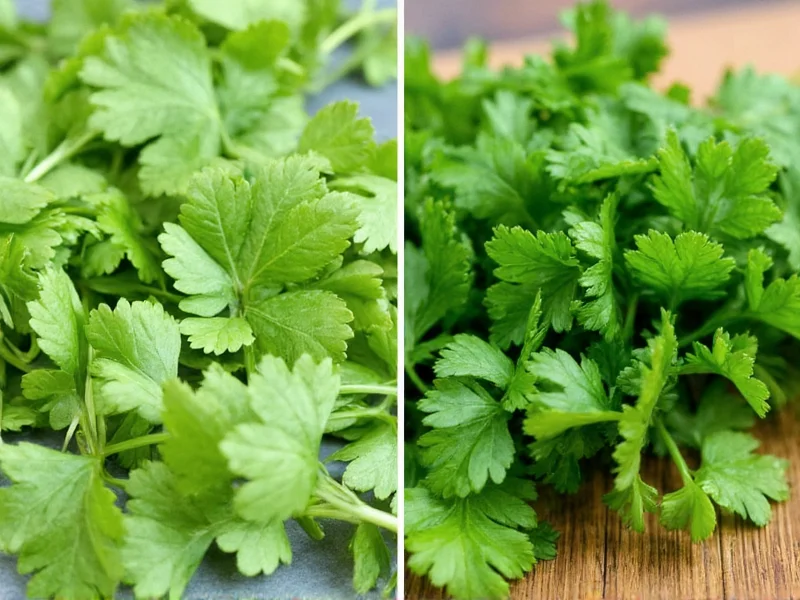When comparing cilantro vs parsley taste, understanding their distinct flavor profiles is essential for culinary success. These two herbs, often confused due to similar appearances, deliver dramatically different sensory experiences that can make or break your dish. Knowing the precise cilantro vs parsley flavor profile differences helps home cooks and professional chefs alike select the right herb for any recipe.
The Fundamental Taste Difference Explained
Cilantro (also known as coriander leaf or Chinese parsley) delivers an intense, polarizing flavor experience. Approximately 21% of the population carries a genetic variant (OR6A2) that makes cilantro taste like soap due to heightened sensitivity to aldehyde compounds also found in soap. For those without this gene variant, cilantro offers vibrant citrus notes with hints of pepper and earthiness.
Parsley, particularly the flat-leaf Italian variety preferred by chefs, provides a much milder, clean green flavor with subtle peppery undertones. Unlike cilantro's bold personality, parsley serves as a supporting player that enhances other ingredients without dominating the dish. Curly parsley has an even more neutral profile, making it primarily a garnish rather than a flavor contributor.
| Characteristic | Cilantro | Parsley (Flat Leaf) |
|---|---|---|
| Primary Flavor Notes | Citrus, lemon, pepper, sometimes soapy | Grassy, mild green, subtle pepper |
| Intensity | Strong, dominant | Mild, complementary |
| Genetic Impact | 21% perceive as soapy (OR6A2 gene) | No significant genetic taste variation |
| Culinary Role | Star ingredient in specific cuisines | Versatile background note |
| Heat Stability | Loses flavor quickly when cooked | Holds up better to cooking |
The Science Behind Cilantro's Divisive Flavor
The dramatic difference in cilantro vs parsley taste perception stems from specific chemical compounds. Cilantro contains high levels of aldehydes—organic compounds also present in soap and lotions. People with the OR6A2 gene variant have olfactory receptors that detect these aldehydes more intensely, creating the soapy sensation. This genetic variation explains why cilantro taste preferences vary so dramatically across populations, with higher prevalence among people of European descent (up to 24%) compared to Latin American populations (only 4%).
Parsley lacks these specific aldehydes, resulting in a more universally accepted flavor profile. Its chemical composition features apiol and myristicin, which provide that clean, green note without the polarizing effect of cilantro's compounds. This fundamental chemical difference is why understanding cilantro vs parsley taste is crucial for recipe development and ingredient substitution.
Culinary Applications: When to Use Each Herb
Knowing the difference between cilantro and parsley taste directly impacts your cooking decisions. Cilantro shines in dishes where its bold flavor complements other strong ingredients:
- Use fresh cilantro in salsas, guacamole, and ceviche where its citrus notes enhance acidity
- Add at the end of cooking to preserve its delicate flavor (heat destroys cilantro's volatile compounds)
- Essential in Southeast Asian, Indian, and Latin American cuisines where its distinctive flavor defines the dish
Parsley's versatility makes it suitable for broader applications:
- Use flat-leaf parsley in tabbouleh, gremolata, and chimichurri where its mild flavor supports other ingredients
- Add during cooking as it withstands heat better than cilantro
- Perfect for finishing sauces, soups, and roasted vegetables without altering the fundamental flavor profile
Substitution Guidance: Can You Replace One With the Other?
When considering can I substitute parsley for cilantro, the answer depends on your recipe and personal taste preferences. In dishes where cilantro is a featured ingredient (like salsa or Thai curry), parsley won't provide the necessary citrus notes and will significantly alter the dish's character. However, in recipes where cilantro serves as a minor garnish, flat-leaf parsley makes an acceptable substitute.
For those who perceive cilantro as soapy, consider these alternatives:
- Use a combination of parsley and a squeeze of lime to mimic cilantro's citrus notes
- Try culantro (not the same as cilantro), which has a similar flavor profile but holds up better to cooking
- Add a small amount of coriander seed (ground) for a subtle citrus note without the soapy perception
Visual Identification Tips
While this article focuses on cilantro vs parsley taste, visual identification helps prevent culinary mistakes. Cilantro leaves have rounded, lacy edges with a more delicate appearance, while flat-leaf parsley has pointed, serrated edges and a glossier sheen. Cilantro stems are thinner and more fragile compared to parsley's sturdier stems. When in doubt, crush a leaf between your fingers—cilantro releases a much stronger, distinctive aroma than parsley.
Common Misconceptions Clarified
Many home cooks believe cilantro and parsley are interchangeable, but the difference between cilantro and parsley taste proves otherwise. Another misconception is that "coriander" refers to a different plant—actually, coriander refers to the seeds of the cilantro plant, while the leaves are called cilantro. Understanding these distinctions prevents recipe failures and helps you make informed decisions when shopping for ingredients.











 浙公网安备
33010002000092号
浙公网安备
33010002000092号 浙B2-20120091-4
浙B2-20120091-4